Glycolysis is a catabolic pathway in the living cells. It occurs in the cytosol of a cell and converts glucose into pyruvate. It is derived from the Greek words; glykys, sweet, and lysis, meaning breakdown. Embden, Meyerhof, and Parnas described this pathway. Hence, it is also called the Embden-Meyerhof pathway (EM pathway).
Definition
Glycolysis is a series of reactions for the breakdown of Glucose (a 6-carbon molecule) into two molecules of pyruvate (a 3-carbon molecule) under aerobic conditions; or lactate under anaerobic conditions along with the production of a small amount of energy.
Introduction
- Glycolysis is a sequence of ten steps that extracts energy from glucose molecules.
- It is the first step towards glucose metabolism.
- It occurs in both aerobic and anaerobic conditions.
- In aerobic states, pyruvic acid enters the citric acid cycle. It undergoes oxidative phosphorylation that leads to ATP production.
- In anaerobic states, pyruvic acid converts to lactic acid, and the net production of 2 ATP molecules occurs.
- A single glucose molecule consumes 2 ATP molecules and produces 4 ATP, 2 NADH, and two pyruvates. This pyruvate molecule is used in the citric acid cycle or as a precursor for other reactions.
Difference between Glycolysis and Gluconeogenesis
| Glycolysis | Gluconeogenesis |
| It is a series of reactions that converts glucose into pyruvate. | It is a series of reactions that produces glucose from non-carbohydrate molecules. |
| It is a catabolic process. | It is an anabolic process. |
| The raw material used is glucose. | The raw material used is lactate and amino acids. |
| Occurs only in the cytoplasm. | Occurs both in the cytoplasm and mitochondria. |
| It has a series of ten reactions | Two essential irreversible steps will be bypassed by four new reactions |
Difference between Glycolysis and Citric acid cycle (Krebs cycle/TCA cycle)
| Glycolysis | Citric acid cycle (Krebs cycle/TCA cycle) |
| A series of reactions that convert glucose molecule into two pyruvate molecules | A series of reactions that convert pyruvate molecules into Acetyl CoA and then CO2 and H2O. |
| It is the first step of cellular respiration. | It is the second step of cellular respiration. |
| It occurs in both aerobic and anaerobic respiration. | It occurs only in aerobic respiration. |
| It occurs in the cytoplasm. | It occurs in mitochondria. |
| It is a linear process. | It is a cycle. |
| The end product is an organic substance. | The end product is an inorganic substance. |
| Produces two NADH, two ATPs, and two Pyruvate molecules. | Produces six NADH and two FADH2 molecules. |
| It consumes two ATP molecules. | It consumes no ATPs. |
| The net gain is 08 ATPs. | The net gain is 24 ATPs. |
| CO2 is not released. | CO2 is released. |
| Don’t use O2. | Uses O2. |
Biochemical significance of Glycolysis
- It is a significant route for carbohydrate metabolism
- It takes place in all the cells of the body
- It is the only pathway that can act in an aerobic and anaerobic environment.
- Skeletal muscles can survive because of anaerobic glycolysis.
- Glycolysis is the only source of energy in erythrocytes.
- The majority of glycolytic pathway reactions are reversible, which is essential for gluconeogenesis or the formation of new glucose.
Clinical significance of Glycolysis
- Pyruvate kinase enzyme deficiency is an autosomal recessive disorder that causes hemolytic anemia.
- Arsenic replaces phosphate in glycolysis steps, which is why arsenic poisoning prevents ATP synthesis.
- Exercise intolerance is caused by muscle Phosphofructokinase deficiency.
Types of Glycolysis
There are two main types of glycolysis; aerobic and anaerobic.
Aerobic Glycolysis
Aerobic means in the presence of oxygen. Aerobic glycolysis occurs when oxygen is sufficient. First, glucose is converted into pyruvate, and then pyruvate will be oxidized to the final products CO2 and H2O.
Anaerobic Glycolysis
Anaerobic means in the absence of oxygen. First, glucose is converted into pyruvate and then pyruvate into lactate.
Phases of Glycolysis
There are two main phases of glycolysis.
- The energy-requiring phase (Preparatory phase)
- The energy-releasing phase. (Payoff phase)
Glucose-requiring phase (Preparatory Phase)
- This phase is also called the glucose activation phase. In this phase of glycolysis, two molecules of ATP are invested, and the hexose chain is cleaved into two triose phosphates.
- During this phase, the phosphorylation of glucose and its conversion to glyceraldehyde-3-phosphate occurs.
Energy-releasing phase (Payoff Phase)
- This phase is also called the energy extraction phase. During this phase, the conversion of glyceraldehyde-3-phosphate to pyruvate takes place.
- In this process, one NADH and two ATP molecules are formed.
Equation of Glycolysis
The following equation well summarizes the process of glycolysis:
C6H12O6 + 2ADP + 2Pi + 2NAD+ → 2C3H4O3 + 2H2O + 2ATP + 2NADH + 2H+
C6H12O6 is glucose and C3H4O3 is pyruvate. ADP and NAD stand for Adenosine diphosphate and Nicotinamide adenine dinucleotide, respectively.
Steps of Glycolysis
Glycolysis is a lengthy process. It has the following steps.
Step 1 : Uptake and Phosphorylation of Glucose
- Glucose is phosphorylated to form glucose-6-phosphate.
Hexokinase
- Phosphate group is transferred from ATP to Glucose.
- It is an irreversible step
- Hexokinase has a high affinity for glucose
- Mg2+ is the cofactor in this reaction
- Hexokinase is a key glycolytic enzyme.
- Glucose is phosphorylated to form glucose-6-phosphate.
Glucokinase
- It is present in the liver, where it removes the glucose from the portal vein following a meal.
- Also present in pancreatic cells, where it releases insulin.
- It acts only when blood glucose is more than 100mg/dL.
- Glucokinase has a high affinity for glucose
Step 2 : Isomerization of Glucose-6-Phsphate to Fructose-6-Phosphate
- Glucose-6-phosphate is isomerized to fructose-6-phosphate by phosphohexose isomerase.
- For the reaction to take place, it needs the help of aldose-ketose isomerization using a catalyst phosphohexose isomerase.
- It causes the glucopyranose ring’s opening to a linear structure changing the structure of the furanose ring of fructose-6-phosphate.
Step 3 : Phosphorylation of F-6-P to Fructose 1,6-Biphosphate
- Fructose-6-phosphate is further phosphorylated to fructose 1,6-bisphosphate.
- The enzyme is phosphofructokinase-1. It catalyzes the transfer of a phosphate group from ATP to fructose-6-phosphate.
- It will be the second irreversible step.
- It is a major regulatory step of glycolysis.
- One ATP is utilized in this step.
- Phosphofructokinase-1 is the key enzyme in glycolysis that regulates the breakdown of glucose.
- It is also called the bottleneck or committed step of glycolysis.
Step 4 : Cleavage of Fructose 1,6-Biphosphate
- The 6-carbon fructose-1,6-bisphosphate is cleaved into two 3-carbon compounds; one glyceraldehyde-3-phosphate (GAP) and another one is dihydroxyacetone phosphate (DHAP).
- The enzyme which catalyzes the reaction is aldolase. Since the backward reaction is an aldol condensation, the enzyme is called aldolase.
- The reaction is reversible.
Step 5 : Interconversion of the Triose Phosphates
- GAP is on the direct pathway of glycolysis, whereas DHAP is not. Hence Triose-phosphate isomerase converts DHAP into GAP useful for generating ATP. Thus net result is that glucose is now cleaved into 2 molecules of glyceraldehyde-3-phosphate.
- This reaction is rapid and reversible.
Step 6 : Oxidative phosphorylation of GAP to 1,3-Bisphosphoglycerate
- The first step in the payoff phase is the oxidation of glyceraldehyde 3-phosphate to a high-energy compound, 1,3-bisphosphoglycerate.
- This reaction is catalyzed by glyceraldehyde 3-phosphate dehydrogenase.
- It is an energy-yielding reaction. During this reaction, NAD+ is reduced and NADH is generated by adding inorganic phosphate.
- This is a reversible reaction.
- Under aerobic conditions, NADH enters into mitochondria.
- Under anaerobic conditions, NADH is utilized by Lactate Dehydrogenase.
Step 7 : Conversion of 1,3-Biphosphoglycerate to 3-Phosphoglycerate
- The enzyme 1,3-bisphosphoglycerate kinase transfers the high-energy phosphoryl group from the carboxyl group of 1,3-bisphosphoglycerate to ADP, forming ATP and 3-phosphoglycerate.
- The 1,3-bisphosphoglycerate kinase is the only kinase in glycolysis that is reversible.
- This is a unique example where ATP can be produced at the substrate level without participating in the electron transport chain. This type of reaction where ATP is formed at substrate level is called Substrate level phosphorylation.
Step 8 : Conversion of 3-Phosphoglycerate to 2-Phosphoglycerate
- 3-phosphoglycerate is isomerized to 2-phosphoglycerate by shifting the phosphate group from 3rd to 2nd carbon atom.
- The enzyme is phosphoglycerate mutase.
- This is a readily reversible reaction.
- Mg2+ is essential for this reaction.
Step 9 : Dehydration of 2-Phosphoglycerate to Phosphoenolpyruvate
- 2-phosphoglycerate is converted to PhosphoenolPyruvate
- The enzyme used is Enolase that requires Mg++.
- The step involves dehydration and one water molecule is removed.
- A high-energy phosphate bond is produced. The reaction is reversible.
Step 10 : Conversion of Phosphoenol Pyruvate to Pyruvate
- Phosphoenolpyruvate (PEP) is dephosphorylated to pyruvate, by pyruvate kinase.
- It will be the second substrate-level phosphorylation.
- One mole of ATP is generated during this reaction.
- This step is irreversible.
Additional Step in Anaerobic Condition
When animal tissues cannot be supplied with sufficient oxygen to support aerobic oxidation of the pyruvate and NADH produced in glycolysis, NAD+ is regenerated from NADH by the reduction of pyruvate to lactate.
Some tissues and cell types (such as erythrocytes, which have no mitochondria and thus cannot oxidize pyruvate to CO2) produce lactate from glucose even under aerobic conditions.
The reduction of pyruvate is catalyzed by lactate dehydrogenase.
Fates of pyruvate
The fate of pyruvate depends on the organism and metabolic conditions. It can be one of the following three
Alcohol fermentation
It occurs in yeast. In anaerobic states, pyruvate is converted to ethanol and CO2.
Lactic acid fermentation
In the cells like skeletal muscle cells, pyruvate is reduced into lactate. It occurs in anaerobic conditions.
Oxidation
In the presence of oxygen, pyruvate is moved to the mitochondria, where it is oxidized into acetyl Co-A. It further goes into the citric acid cycle and converts to CO2 and H2O.
Net energy (ATP) yield per molecule of Glucose in Glycolysis
Energy Yield in Aerobic Glycolysis
| Step | Enzyme | Source | No. of ATP |
|---|---|---|---|
| 1 | Hexokinase | – | -1 |
| 3 | Phosphofructokinase | – | -1 |
| 6 | Glyceraldehyde-3- phosphate dehydrogenase | NADH | (+3) x 2 = +6 |
| 7 | Phosphoglycerate kinase | ATP | (+1) x 2 = +2 |
| 10 | Pyruvate kinase | ATP | (+1) x 2 = +2 |
| Net Yield | 8 ATPs |
Energy Yield in Anaerobic Glycolysis
| Step | Enzyme | Source | No. of ATP Formed/consumed |
|---|---|---|---|
| 1 | Hexokinase | – | -1 |
| 3 | Phosphofructokinase | – | -1 |
| 7 | Phosphoglycerate kinase | ATP | (+1) x 2 = +2 |
| 10 | Pyruvate kinase | ATP | (+1) x 2 = +2 |
| Net Yield | 2 ATPs |
Frequently Asked Questions
Q 1. How many ATPs are produced in aerobic glycolysis?
Q 2. How many ATPs are produced in anaerobic glycolysis?
Q 3. Where does glycolysis occur?
Q 4. What is the end product of glycolysis?
Q 5. How a defect in the process of glycolysis leads to anemia?
Q 6. Is glycolysis aerobic or anaerobic?
Q 7. What are the functions of glycolysis?
2. It supplies the cells ample levels of oxygen when performing strenuous activities.
3. It gives carbon skeletons for non-essential amino acid synthesis.
4. It is vital for the formation of new glucose.
Q 8. Does glycolysis occur in all cells?
Q 9. What are the tissues that depend mainly on glucose as metabolic fuel?
2. Skin
3. White fibers of skeletal muscle
4. Brain
5. Renal medulla
6. GIT
Q 10. What are the irreversible steps of glycolysis?
2. Pyruvate kinase
3. Phosphofructokinase
Q 11. What is Glucose?
An aldehyde group is attached to the first carbon atom. The remaining five carbons have one hydroxyl group each. Glucose 6-phosphate is the specific form of glucose that is used in the process of glycolysis.
Q 12. What enzymes are used in glycolysis?
1. Hexokinase
2. Phosphoglucoisomerase
3. Phosphofructokinase
4. Aldolase
5. Phosphotriose isomerase
6. Glyceraldehyde 3-phosphate dehydrogenase
7. Phosphoglycerate kinase
8. Phosphoglycerate mutase
9. Enolase
10. Pyruvate kinase

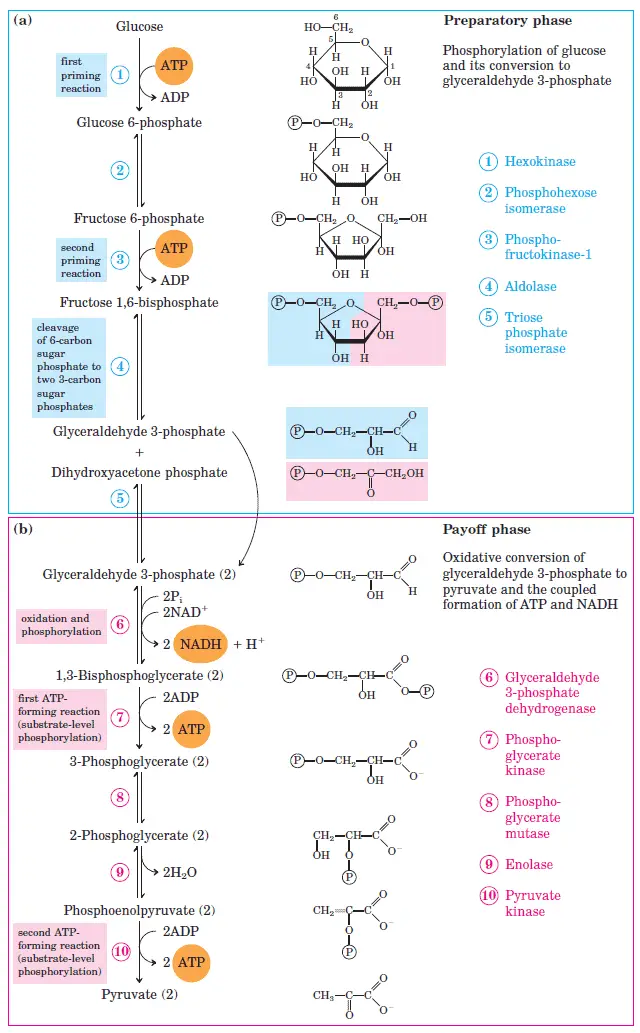

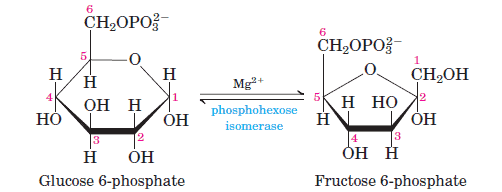


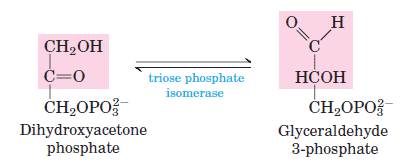



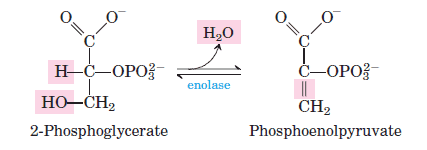

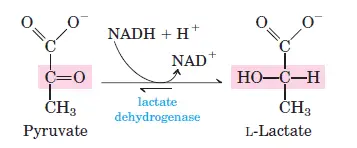
Thank you your article help me a lot.
Thanks for the elaborate explanation on glycolysis.
This was super informative! Thank you!!
you have really explained this to the best level…you are a genius
Thanks for the explanation is makes studies easy
awsome!thanks
perfectly explained
this is really awesome ….Thanks a lot
This article is easy and conscise
Great explanation.thanks
thanks for ur illustration
Tnks for ur brother assistant, may God be with u ameen
it was rilie helpful. tnx a lot
Its gud, ahsante
excellent description…thanks a lot
Excellent description… Thank you so much
Thank you so much for this informative ppt
Thank you for breaking it down
thanku so much for excellent description
Perfectly explained….
This explanation is amazing !! I can finally understand the whole process in an easier way
you are a genius
thank u so much it was really helpful, i appreciate
This is a very clear description of glycolysis. It helped us to understand and memorize the steps of glycolysis very easily. Thank you very much.
Nice work this is best summary of glycolysis to be used